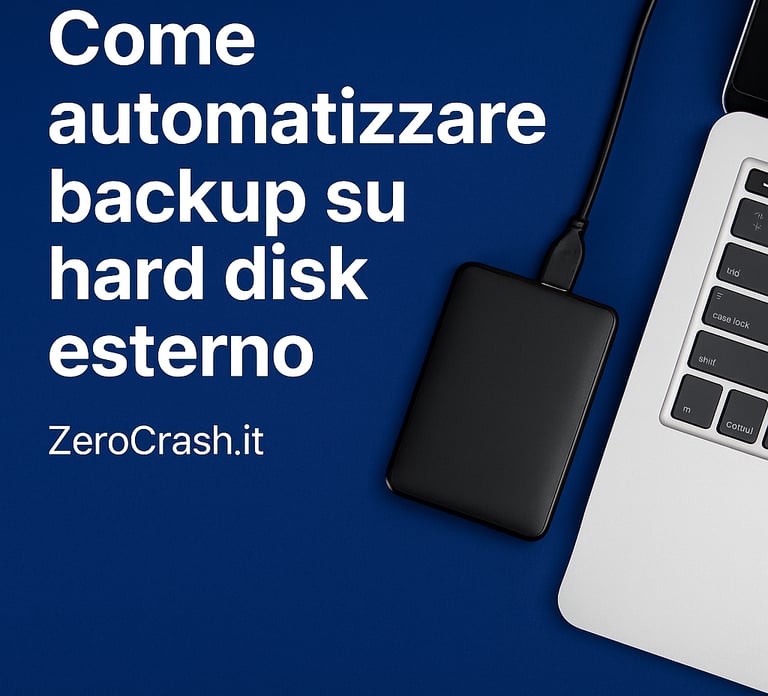How to automate backups to an external hard drive (no paid software needed)
A complete and field-tested guide to automatically back up files to an external USB drive, using only built-in tools. Includes scripts, real examples and step-by-step instructions for both Windows and Linux users.
SMART TIPS
ZeroCrash
7/20/20252 min read
How to automate backups to an external hard drive (no paid software needed)


TIPS – Tricks, Ideas, Practical Stuff.
Smart solutions tested in real life, explained with no fluff.
If it works, it’s here. If it’s junk, we throw it out before you see it.
Why avoid paid backup software?
Because if all you need is to regularly copy your folders to an external drive, paying €49/year for a shiny interface is overkill.
Windows and Linux already have everything you need onboard.
You just have to know where to look — and that’s what we’re here for.
✅ The Goal
Set up an automated backup system for your:
documents
photos
important folders
…to an external USB hard drive, in a totally automatic, safe and free way.
Works on both Windows 10/11 and Linux (Ubuntu, Mint, Debian, etc.).
🧩 Method 1 – Windows only (Robocopy + Task Scheduler)
📁 Step 1 – Connect your external drive
Plug it into your PC via USB
Note the drive letter, e.g. E:\
Create a backup folder, like E:\BackupZero
✍️ Step 2 – Create a batch file
Open Notepad
Paste this code:
robocopy "C:\Users\YourName\Documents" "E:\BackupZero\Documents" /MIR /R:1 /W:5 /LOG:"E:\BackupZero\log.txt"
Save as: backup_auto.bat
File type: All files
Save it somewhere like: C:\Scripts
📌 /MIR mirrors the folder (adds new files, deletes removed ones)
📌 /R:1 retries once if it fails, /W:5 waits 5 seconds between attempts
⏱️ Step 3 – Automate with Task Scheduler
Search for “Task Scheduler” in the Start menu
Create a new task
In General tab:
Name: BackupZero
Run with highest privileges
In Triggers:
Choose “At log on” or “At disk insertion” (advanced)
In Actions:
Run: C:\Scripts\backup_auto.bat
👉 Done! Now your backup runs on schedule or when the drive is connected.
🐧 Method 2 – Linux only (rsync + cron)
📁 Step 1 – Detect the external drive
Plug in your USB drive and run:
lsblk
Find the correct name, e.g. /dev/sdb1, and mount point like /media/username/BackupZero.
Double check with:
df -h
📦 Step 2 – Install rsync (if missing)
sudo apt install rsync
✍️ Step 3 – Create the backup script
Open your favorite editor, e.g. Nano:
nano ~/backupzero.sh
Write this:
#!/bin/bash
SRC="/home/your-user/Documents"
DEST="/media/your-user/BackupZero/Documents"
rsync -av --delete "$SRC/" "$DEST/"
Save and make it executable:
chmod +x ~/backupzero.sh
⏱️ Step 4 – Add it to your crontab
Open the crontab:
crontab -e
Add this line:
0 20 * * * /home/your-user/backupzero.sh
👉 That’s a backup every day at 8:00 PM.
You can also trigger it on disk insertion using udev rules, but that requires extra steps (let me know if you need them).
🔐 Logs & Security
Limit access to the script: chmod 700
Add a log file for every run:
Windows:
/LOG+:"E:\BackupZero\log.txt"
Linux:
rsync ... >> /media/your-user/BackupZero/log.txt
📌 Final tips
If your drive letter changes (e.g. E:\ becomes F:), update the script
Use specific folders, don’t back up the entire disk
Avoid tools that delete everything if the drive isn’t detected
Test your backup system before relying on it fully
✅ In short
You now have a complete guide to back up your files automatically to an external drive — using only built-in tools and zero cost.
Flexible, reliable, and fully customizable.
ZeroCrash
Social
Practical guides to solve tech problems.
Contacts
Join the ZeroCrash Club
© 2025 ZeroCrash | Powered by cervello + coffee | All rights reserved.
